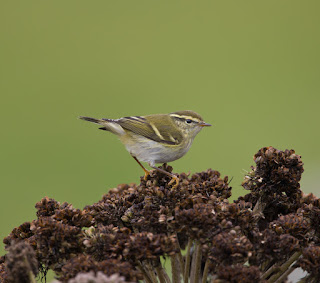I reckon I have pretty good sea legs. I was only ever sea sick once and that was in a force ten gale on the southern Atlantic Ocean. But I had been warned that the Good Shepherd can be rough so I was expecting the worst - especially over four hours to Lerwick. As it happened it was fine, when I wasn't below decks dozing I was up in the wheel house or out the back looking at Tysties (Black Guillemots), Fulmars (including some dark ones) and Bonxies.
 |
| The bog door on the Good Shepherd - someone has a sense of humour |
 |
| Sumburgh Head Mainland in the background |
 |
| Broch, Bressay, Shetland |
 |
| Arriving in Lerwick |
For the rest of day I birded around Sumburgh Head, Sumburgh Lighthouse, Virkie Willows and the Pool of Virkie. At Sumburgh Hotel I had two YBWs in the garden.
 |
| Sumburgh Hotel gardens |
By now the early start was catching up on me. I went back to the hotel and had a kip, but it didn't last to long. I was woken by a text from James Lowen "Thick billed Warbler quendale if you still on shetland". Holy cow!!!!
Within ten minutes I was parking up at Quendale mill and ten minutes later I had Thick billed Warbler on my life list. Like everyone else there I had flight views only. A large babbler-like / shrike-like bird, long-tailed, seemingly short winged and quite rufous. The light was almost gone so we all called it a day. Credit must go to James Lowen for texting me, the bird was gone the next morning and if it hadn't been for James's message I'd have missed it.
The next day I birded during the morning around Boddam, Virkie and Levenwick. The weather was beautiful but the only birds of note were two YBWs and a few Willow Warblers. I returned to the hotel and spent the afternoon trying to get some nice shots of YBW in the sycamores of the hotel garden.
 |
| Yellow-browed Warbler, Sumburgh Hotel Garden |
So that was Fair Isle for me. Would I go again? Yes, of course, but you pay your money and take your chance. You could score big-time on Fair Isle and see some amazing birds or see very little at all or somewhere in between, which I think is where I was placed. The best birds I had were actually on Mainland (Western Bonelli's Warbler and Thick-billed Warbler). But I was part of an unprecedented arrival of Yellow-browed Warblers, got some great shots of a Blyth's Reed and spent time in a truly awesome part of the world. And the autumn is not over yet - not by a long way!




















































